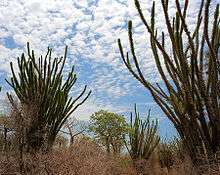Alluaudia procera
| Madagascar ocotillo | |
|---|---|
 | |
| Scientific classification | |
| Kingdom: | Plantae |
| (unranked): | Angiosperms |
| (unranked): | Eudicots |
| (unranked): | Core eudicots |
| Order: | Caryophyllales |
| Family: | Didiereaceae |
| Genus: | Alluaudia |
| Species: | A. procera |
| Binomial name | |
| Alluaudia procera (Drake) Drake | |
| Synonyms[1] | |
|
Didierea procera Drake | |
Madagascar ocotillo or Alluaudia procera, is a deciduous succulent plant species of the family Didiereaceae.
It is endemic to south Madagascar.[1]
Description
This plant is a spiny succulent shrub, with thick water-storing stems and leaves that are deciduous in the long dry season. Although strikingly similar in appearance, it is not closely related to the ocotillo, Fouquieria splendens of the Sonoran Deserts in North America.
Young alluaudias form a tangle of stems that last for several years after which a strong central stem develops. The basal stems then die out leaving a tree-like stem that branches higher up on the main trunk.[2]
Like other members of Didiereaceae family, the leaves of Alluaudia, produced from brachyblasts similar to areoles found in cacti, are small, appear single and are accompanied with conical spines. Its flowers are unisexual and radially symmetric.
Taxonomy
The Didiereaceae comprise 11 species divided into 4 genera, of which the largest is Alluaudia (six species). Alluaudia has been subdivided into the 2 sections Alluaudia and Androyella.[3] In this way, Alluaudia procera has two sisters, Alluaudia ascendens and Alluaudia montagnacii.
Based on molecular phylogeny conducted[4] Alluaudia, Alluaudiopsis, and Didierea from the family are all supported as monophyletic. Relationships within the genus Alluaudia are relevant to the evolution of polyploidy within the family.
Researchers haven’t figured out where the Didiereaceae family originates from. However, the nearest relative of the Didiereaceae, Calyptrotheca somalensis, is endemic to East Africa,[5] where the island of Madagascar separated from 100 million years ago.[6] Thus, the Didiereaceae family species may have originated from the dispersal to Madagascar of a Calyptrotheca-like East African ancestor.
See also
- Endemic flora of Madagascar
- Madagascar spiny forests ecoregion
- Alluaudia (beetle)
References
- 1 2 Kew World Checklist of Selected Plant Families
- ↑ World Conservation Monitoring Centre (1998). "Alluaudia procera". IUCN Red List of Threatened Species. Version 2006. International Union for Conservation of Nature. Retrieved 11 May 2006.
- ↑ Rabesa, Zafera Antoine (1982). "Definition de deux sections du genre Alluaudia (Didiereaceae)". Taxon. 31: 339–358.
- ↑ Applequist, W. L. (2000). "Phylogeny of the Madagascan endemic family Didiereaceae". Plant Systematics and Evolution. 221: 157–166. doi:10.1007/bf01089291.
- ↑ Nyananyo, B. L. (1986). "The systematic position of the genus Calyptrotheca Gilg (Portulacaceae)". Feddes Report. 97: 767–769. doi:10.1002/fedr.4910971109.
- ↑ Raven, Peter H.; Axelrod, Daniel I. (1974). "Angiosperm biogeography and past continental movements". Ann. Missouri. Bot. Gard. 61: 539–673. doi:10.2307/2395021.
| Wikimedia Commons has media related to Alluaudia procera. |
